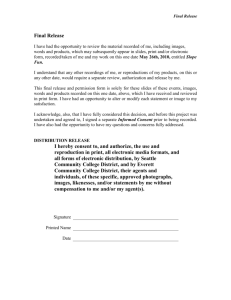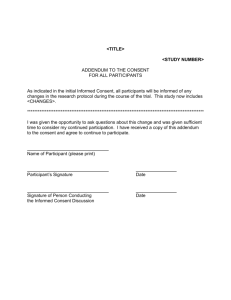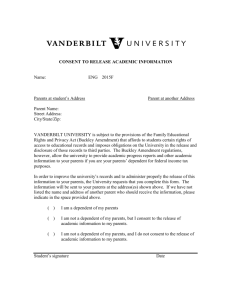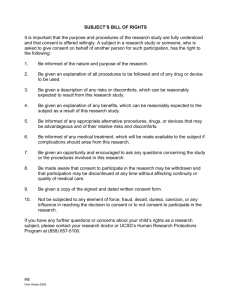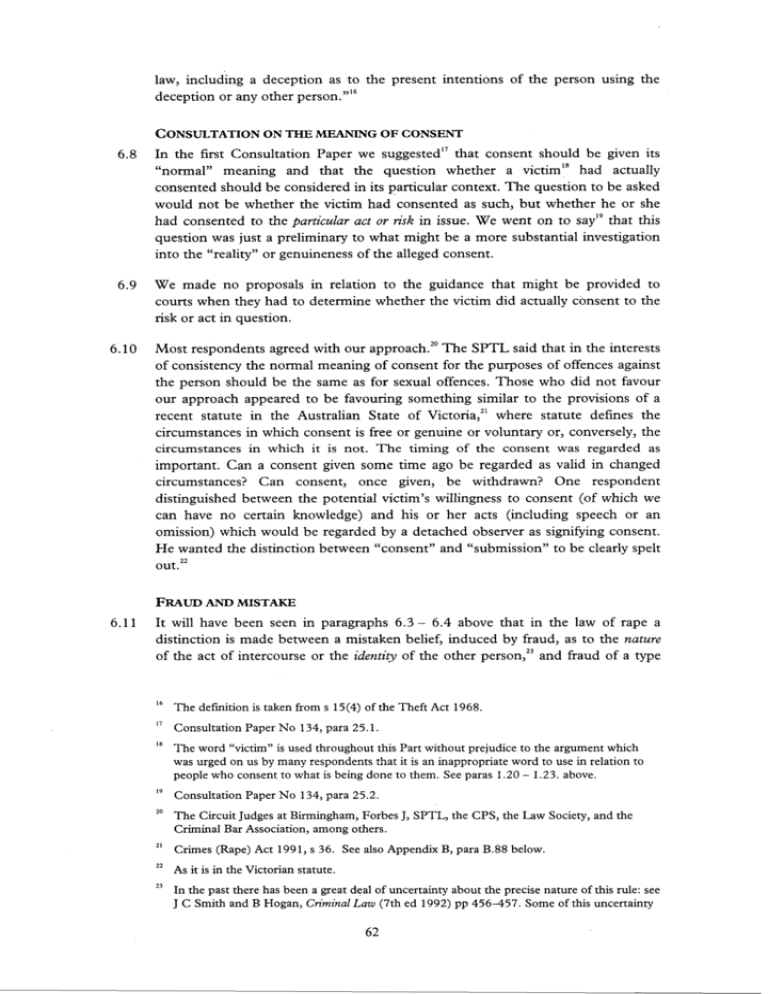
law, including a deception as to the present intentions of the person using the
deception or any other person.”’6
CONSULTATION ON THE MEANING OF CONSENT
6.8
In the first Consultation Paper we suggested17 that consent should be given its
“normal” meaning and that the question whether a victim” had actually
consented should be considered in its particular context. The question to be asked
would not be whether the victim had consented as such, but whether he or she
had consented to the particular act or risk in issue. We went on to sayL9that this
question was just a preliminary to what might be a more substantial investigation
into the “reality” or genuineness of the alleged consent.
6.9
We made no proposals in relation to the guidance that might be provided to
courts when they had to determine whether the victim did actually consent to the
risk or act in question.
6.10
Most respondents agreed with our approach.20The SPTL said that in the interests
of consistency the normal meaning of consent for the purposes of offences against
the person should be the same as for sexual offences. Those who did not favour
our approach appeared to be favouring something similar to the provisions of a
recent statute in the Australian State of Victoria,21 where statute defines the
circumstances in which consent is free or genuine or voluntary or, conversely, the
circumstances in which it is not. The timing of the consent was regarded as
important. Can a consent given some time ago be regarded as valid in changed
circumstances? Can consent, once given, be withdrawn? One respondent
distinguished between the potential victim’s willingness to consent (of which we
can have no certain knowledge) and his or her acts (including speech or an
omission) which would be regarded by a detached observer as signifying consent.
He wanted the distinction between ‘‘consent” and “submission” to be clearly spelt
FRAUD AND MISTAKE
6.1 1
It will have been seen in paragraphs 6.3 - 6.4 above that in the law of rape a
distinction is made between a mistaken belief, induced by fraud, as to the nature
of the act of intercourse or the identity of the other person,23and fraud of a type
l6
The definition is taken from s 15(4) of the Theft Act 1968.
17
Consultation Paper No 134, para 25.1.
18
The word “victim” is used throughout this Part without prejudice to the argument which
was urged on us by many respondents that it is an inappropriate word to use in relation to
people who consent to what is being done to them. See paras 1.20 - 1.23. above.
19
Consultation Paper No 134, para 25.2.
20
The Circuit Judges at Birmingham, Forbes J, SPTL, the CPS, the Law Society, and the
Criminal Bar Association, among others.
21
Crimes (Rape) Act 1991,s 36. See also Appendix B, para B.88 below.
22
As it is in the Victorian statute.
23
In the past there has been a great deal of uncertainty about the precise nature of this rule: see
J C Smith and B Hogan, Criminal Law (7th ed 1992) pp 4 5 6 4 5 7 . Some of this uncertainty
62
that does not affect a person’s understanding of these two matters. In its original
Working Paperz4the CLRC suggested dispensing altogether with fraud in rape,
but in the end it decided to make the clear distinction that has now found its way
into sections 89(2)(b) and 90 of the Draft Code. The difficulties caused by the
Government’s failure to modernise the law in accordance with the CLRC’s
recommendations can be seen in two very recent cases.
’
6.12
In L i n e k ~ ?a~prostitute agreed to provide her services for an agreed sum of E25,
which her customer had no intention of paying. The Court of Appeal held that
the fraud did not nullify her consent to intercourse. If the CLRC’s
recommendations had been implementedYz6
there would have been no question of
a very experienced Old Bailey judge” directing the jury that it might convict the
defendant of rape on this basis even if it was not willing to accept the
complainant’s story that he forced himself violently upon her.’*
6.13
In ElbekkayY2’on the other hand, the Court of Appeal considered that it was still
at liberty to decide, as a matter of common law, notwithstanding the interventions
of statute in 1885, 1956 and 1976,” that when a woman consented to sexual
intercourse in the belief that it was her regular male partner who had got into bed
with her, her consent was nullified by this impersonation, notwithstanding that
section 7 ( 3 ) of the Sexual Offences Act 1956 makes no reference to impersonation
of anyone other than a husband. Once again, the implementation of the CLRC’s
recommendations” would have avoided all this difficulty.
6.14
In recommending that consent obtained by the impersonation of a man other
than a husband should constitute rape the CLRC said quite briefly that it could
see no reason to distinguish between different types of impers~nation.~’
More
recently, one commentator has suggested that an analogy might usefully be drawn
from the civil law, where a fundamental mistake that relates to the material
identity of the other party to a contract or to the nature of the subject matter of
may have been resolved by the recent case of Elbekkuy [ 19951 Crim LR 163: see para 6.13
below.
24
25
CLRC, Working Paper on Sexual Offences (1980), paras 20-25.
[1995] QB 250.
26
These are now set out in ss 89(2) and 91 of the Draft Code. See paras 6.5 and 6.7 above.
27
Judge Michael Coombe.
28
The jury, in effect, returned a special verdict at the judge’s request.
’’
[I9951 Crim LR 163.
30
T h e Court of Appeal did not fully explain why it considered itself at liberty to go back
beyond the 1956 consolidation Act to examine the history that led to the enactment of s 4 of
the Criminal Law Amendment Act 1885. For the relevant principles of statutory
construction, see Fawell z, Alexander [ 19771 AC 59, 84E per Lord Simon of Glaisdale, and
F Bennion, Statutory Interpretation (2nd ed 1992) pp 442-443. And see now N Padfield,
“A Tiger by the Tail: Sexual Offences in the CJPOA 1994” (1995) 2 Archbold News 5,
where a further problem caused by the subsequent amendments to the statute law contained
in s 142 of the Criminal Justice and Public Order Act 1994 is discussed.
31
These are now set out in s 89(2)(b)(ii) of the Draft Code. See para 6.5 above.
3z
CLRC, 15th Report, para 2.25.
63
fraudulently procuring consent to sexual intercourse and the offence of rape (in
which there is no valid consent). In the nineteenth century a judge said: “She
consented to one thing: he did another materially different, on which she had
been prevented by his fraud from exercising her judgment and will.”37Our original
proposals would mean that consent would be nullified by fraud in cases where the
complainant knew exactly what she was consenting to, although she would never
have consented if she had not been deceived about some ancillary matter.
6.17
On consultation most of those who responded accepted our proposals without
explaining their reasons at any great length.38 Three academic respondents,
however, counselled caution. T h e SPTL thought that the proposal would widen
the scope of the criminal law in a wholly unacceptable way, and a Leeds
University group favoured the retention of the present rules.39Discussion centred
round the case of the client who pays a prostitute with a forged banknote, and the
difficulty of stigmatising the act of intercourse (or, in the context of one aspect of
the present project, perhaps, the act of spanking) as itself a non-consensual assault
in these circumstances. Professor Feinberg has drawn4’ a qualitative distinction
between this type of case (where he said that the prostitute is not harmed by the
act itself) and the other familiar type of case, the woman submitting to a vaginal
examination by an impostor doctor (where he suggests that she may well have
been harmed by the very act of examination). We consider, however, that it would
be illegitimate to embody any such distinction in the criminal law, quite apart
from any drafting difficulties that might be involved.
6.18
In spite of the support on consultation, we consider that it would be wrong to
recommend the fundamental change that was suggested in the first Consultation
Paper in the absence of any major new fundamental review of the law relating to
sexual offence^.^' Although there is a powerful argument that the law should
protect people who are ignorant or naively tru~ting,~’
in our view, this protection
should be achieved through the criminal law of deception. Our present view is
that permitting fraud to nullify consent (except in the comparatively narrow range
of cases in which it already has this effect, and possibly another kind of case we
37
Case (1850) 1 Den 580, 582; 169 ER 381,perWilde CJ.
38
They included Garland and Forbes JJ, the Circuit Judges at Birmingham, the CPS, the Law
Society, and the Institute of Legal Executives. Garland J said that fraud as to any aspect of
the transaction, if it was the basis for the consent, should render the consent inoperative.
39
For a thoughtful expression of anxiety about the breadth of the Commission’s proposals, see
D C Ormerod, “Consent and Offences against the Person” (1994) 57 MLR 928, 935-936.
40
J Feinberg, MLCL vol 3, p 296.
41
We received at least one very powerful submission that the law relating to rape ought to be
changed, because “rape by pretence” ought to be treated just as seriously as “rape by
physical force”. It would be wrong, however, to recommend such a substantial change to the
law of rape in the absence of a full law reform study on the subject. Although we are now
embarking on a further round of consultation, we do not at present envisage recommending
that the law relating to consent and sexual offences should be reformed in this way. For our
general approach, see paras 1.7 - 1.8 above.
42
See J Feinberg, MLCL vol 3, p 296.
65
refer to in paragraph 6.19 below) would be di~proportionate.~~
We will therefore
be provisionally proposing44that there should be a general offence (analogous to
that under section 3 of the Sexual Offences Act 1956) of procuring by deception
another person’s consent to an act which would be an offence if done without that
person’s consent; that the penalty for this offence should be, say, a maximum of
five years’ imprisonment; but, provided that the law makes it clear that consent
may be withdrawn a t any time, the circumstances in which fraud may nullify
consent completely should in general be restricted to fraud as to the nature of the
act and the identity of the other person(s) involved.
6.19
We are, however, very concerned about one specific class of case, and we
acknowledge that there may be other particular types of fraud on which we should
also be concentrating our attention. We are referring here to the case where a
person agrees to allow another to have sexual intercourse with him or her after
that other person has untruthfully said that he has been tested for HIV or other
sexually transmitted diseases and that the findings were negative. It seems to us
that this type of fraudulent misrepresentation is morally different from a
fraudulent promise to pay for sexual services, and that it comes close to affecting
the nature of the act itself in that it deals with matters that can have a physical
consequence. We will be asking, thereforeY4’ whether a fraudulent
misrepresentation that a person has had a test for HIV and/or other sexually
transmitted diseases should form an exception to the general rule that fraud
should nullify consent only where it goes to the nature of the act or the identity of
the other person or persons involved in the act, and if so, in what terms this new
class of misrepresentation should be formulated, and whether there are any other
specific types of misrepresentation that also call for extraordinary treatment.
6.20
In this connection we are also concerned about an analogous problem which is
not easily dealt with through the law of consent alone. The device of treating an
apparent consent as invalid, and that of making it an offence to procure a valid
consent by deception, are effective only where the defendant does an act to
another (or to another’s property) which requires the other’s consent if it is not to
be criminal. These devices have no direct application where, instead of doing such
an act with a consent procured by deception, the defendant by deception induces
another person to perform an act upon the defendant. Suppose, for example, that a
woman persuades a man to have unprotected sexual intercourse with her by
falsely telling him that she has been tested and found to be HIV-negative. It would
clearly be unsatisfactory that her liability should depend on proof that the man
actually contracted HIV as a result of that intercourse, or that she intended that he
should contract it (thus incurring liability for attempting to injure him) as distinct
from merely being reckless whether he did, or on the assumption that the
43
The approach of the new Victorian statute to this issue should be noted here. See Crimes
(Rape) Act 1991, s 36(g): “Circumstances in which a person does not freely agree to an act
include the following: (g) the person mistakenly believes that the act is for medical or
hygienic purposes.”
44
See paras 6.81 - 6.82 below.
45
See para 6.80 below.
66
intercourse must have involved acts on her part which, in the absence of the man’s
consent, would have amounted to assaults by her upon him.46
6.2 1
We consider that the woman in this example should be guilty of an offence; but we
invite views as to the exact form that her liability ought to take, and how far (if at
all) beyond this particular situation any proposed solution ought to extend. We ask
whether it should be a specific offence for a person to induce a man by deception
to have sexual intercourse with him or her; if so, whether the offence should be
confined to deceptions as to a particular kind of circumstance, and if so what; and
whether it should include inducing another person to perform any acts other than
sexual intercourse, and if so what.
The requirement for information to be given
6.22
Although this is a matter for continuing discussion in academic circles, the House
of Lords has held4’ that the amount of information a patient should receive if
medical or surgical treatment is not to be regarded as an unlawful battery is
comparatively small. In Chatterton z, Gerxon48Bristow J held that once the patient is
informed in broad terms of the nature of the procedure which is intended and
gives her consent, that consent is real, and this has been accepted as a correct
statement of the law in subsequent decisions.49How much more a doctor should
tell his or her patient in order to avoid a successful action in negligence will turn
on what is recognised as appropriate practice by contemporary standards of care.5o
6.23
In the following parts of this Paper reference will be made from time to time to
the need for the person whose consent is required to understand some, at least, of
the implications of the act to which consent is being given. T h e new regulatory
code for authorising the transplantation of human organs between people who are
not genetically related sets out specific rules by which information about the risks
of organ donation must be given before an operation can be authori~ed.~’
Historically, English criminal law has not paid much attention to a duty to
communicate information to someone about the risks of an activity before his or
her consent can be treated as valid, and we will be interested to hear from
respondents whether they consider that in any particular circumstances any such
duty should be imposed.
46
Cf Mason (1 968) 53 Cr App R 12, where it was held that it is not in itself an indecent assault
for a woman to have sexual intercourse with a boy of 14.
47
In Sidaway v Board of Governors of the Bethlem Royal Hospital [ 19851 AC 87 1.
48
[I9811 QB 432, 442.
49
These are conveniently set out in I Kennedy and A Grubb, Medical Law (2nd ed 1994) pp
15 1-153. In Szdaway (see n 47 above) this principle was adopted by two of the members of the
Court of Appeal (SirJohn Donaldson MR and Dunn LJ), and in his dissenting speech in the
House of Lords Lord Scaxman said that “it would be deplorable to base the law in medical
cases of this kind on the torts of assault and battery.” For a M e r e n t view on what the law
should be, see M A Somerville, “Structuring the Issues in Informed Consent” (198 1) 26
McGill LJ 740,776-779.
50
For which the test set out by McNair J in his charge to the jury in Bolam v Friern Hospital
Management Committee [1957] 1 WLR 582 still contains the governing principles.
51
See paras 8.36
-
8.37 below.
67
Self-induced mistake and non-disclosure
6.24
In the first Consultation Paper we considered the need to clarify the law relating
to “self-induced” or spontaneous mistake. English jurisprudence on this topic was
summarised comprehensively in 1956 by the High Court of Australia in
Papadimitropoulos:’‘
It must be noted that in considering whether an apparent consent is
unreal it is the mistake or misapprehension that makes it so. It is not
the fraud producing the mistake which is material so much as the
mistake itself ... [The stress on the fraud] tends to distract the
attention from the essential inquiry, namely whether the consent is no
consent because it is not directed to the nature and character of the
act. The identity of the man and the character of the physical act that
is done or proposed seem now clearly to be regarded as forming part
of the nature and character of the act to which the woman’s consent is
directed. That accords with the principles governing mistake vitiating
apparent manifestations of will in other chapters of the law.53
In addition to the nineteenth century English cases, the High Court of Australia
also cited the Australian case of Lambed4 and the Canadian case of Harms.55
6.25
We suggested in the first Consultation Paper56that, in order to balance fairness to
the defendant with reasonable protection for the victim, the rule should be that:
(1)
no mistake on the part of the victim should be operative unless it caused the
victim to consent to the risk or impact when otherwise he would not have
done so;
(2)
6.26
if, but only if, the defendant knows that such a mistake has been made he
will be prevented from relying on the victim’s consent as a defence.
This suggestion received widespread support on consultation. We consider that
the second part of this rule should be extended to cover the situation in which a
reckless defendant is aware that a mistake may have been made but carries on
regardles~.~’
A new sub-section-(c) to section 89(2) of the draft Code could read:
(c)
52
because of a mistake as to the nature of the act or the identity of
the man if the defendant knows that such a mistake has been
made or is aware that such a mistake may have been made.
(1957) 98 CLR 249.
53
Ibid, at p 260.
54
[1919] VLR 205, 212, per Cussen J: “Now, carnal knowledge is merely the physical fact of
penetration, though, of course, there cannot be consent even to that without some
perception of what is about to take place.”
55
[1944] 2 DLR 61; see n 35 above.
56
Consultation Paper No 134, para 27.2.
57
See also G Virgo, “When is consent not consent?” (1995) 6 Archbold News 7, where this
approach is also adopted.
68
6.27
The wording of this proposal takes account of our new proposal in relation to
fraud - namely that consent should not in general be nullified by deception as to
any circumstance other than the nature of the act and the identity of the person
doing it, but that deception as to other circumstances should give rise to liability
for a lesser offence than that of non-consensual conduct. Where the defendant is
aware that the other person is or may be mistaken about the nature of the act or
the defendant’s identity, we think that the other person’s consent should be
nullified as if the mistake were induced by fraud. Moreover, a mistaken belief in
certain kinds of fact, such as the defendant’s freedom from sexually transmissible
disease, may arguably be tantamount to a mistake as to the nature of the
Clearly, however, the liability of a person who takes advantage of a self-induced
mistake cannot be greater than that of a person who induces such a mistake by a
deception as to the same circumstances. If a deception as to the circumstance in
question would give rise to liability only for our proposed offence of obtaining
consent by deception, as distinct from the more serious offence of acting without
any consent at all, liability for taking advantage of a self-induced mistake as to that
circumstance could at most be for that lesser offence.
6.28
Whether liability for even the lesser offence would
some cases it probably would be, for example where
to be positively mistaken in the sense of harbouring
defendant knew to be false. It would be difficult to
such a case and one of positive deception.
6.29
A more difficult case, however, is where the other person is known to be making
some unconscious assumption which the defendant knows to be ill-founded. For
example, a man knows he is HIV-positive, but persuades a woman to consent to
unprotected sexual intercourse. If he told her that he was HIV-negative, it would
be a case of deception;59if he knew that a mutual friend had assured her that he
was, it would be a case of exploiting a mistaken belief.6oShould there be any
difference between these cases and the (perhaps more likely) case where the risk of
HIV has not crossed her mind? Should the defendant be under a duty not only to
correct positive mistakes on the other person’s part but also to disclose facts
whose possible existence the other person has not even considered?61
6.30
If such a duty were to be imposed, it would be necessary to define exactly what
be justified is debatable. In
the other person was known
a conscious belief which the
justify a distinction between
must be disclosed. The fact of being HIV-positive would seem one of the
strongest cases for such a duty of disclosure, particularly in the context of consent
to sexual intercourse. But should a man be required to disclose anything else to a
woman before taking advantage of her consent to intercourse? Should any sexually
58
59
See para 6.19 above.
Ibid.
60
See para 6.27 above.
61
It has been held in the criminal law of deception that it is possible to deceive another by
taking advantage of his or her unconscious assumption that everything is as it should be, for
example by tendering a credit card which one has no authority to use: Metropolitan Police
Comwzissioner v Charles [1977] AC 177; Lambie [1982] AC 449. The analogy suggests that
the non-disclosure of clearly material facts might be regarded as deception, and not as selfinduced mistake at all.
69
transmissible disease qualify for this purpose? Or any disease, or any illness? What
if the man suspects that he may have a disease, but does not know for sure?
6.31
Moreover, it would be necessary to identify not only the kinds offact that a person
might be required to disclose, but also the circumstances in which he or she might
be required to disclose them. A person who knows that he or she is HIV-positive
might be required to disclose that fact before having unprotected sexual
intercourse; but would it make a difference if the intercourse were not
unprotected? Or if the other party were believed to be HIV-positive too? And
would such a requirement extend to activities other than sexual intercourse which
also carry a risk of the transmission of HIV? Would a surgeon be required to
disclose her HIV status to her patients before operating on them? Would a rugby
player, or a boxer, be required to disclose it to his team-mates or opponents?
Apart from the obvious problems of definition, there are difficult issues of policy
here. For the surgeon or the boxer, the realistic choice is between non-disclosure
on the one hand and giving up their career or their sport on the other. If the
former option became criminal, the effect might be simply to discourage people
from agreeing to be tested for HIV.
6.32
Finally, if any such duty of disclosure were to be imposed, it would be necessary
to determine whether the effect of non-disclosure would be simply to invalidate a
consent thereby obtained, or to give rise to liability for doing (with the consent
thereby obtained) an act which would be an offence if done without consent; or
whether it should also be an offence for one person to induce another, by failing
to disclose a material fact, to perform certain kinds of act upon him or her- for
example, what form of liability (if any) a woman should incur by having
unprotected sexual intercourse with a man whom she has not told that she is HIVpositive.'j*
6.33
We invite views on how the law should deal with the obtaining of consent by the
non-disclosure of material facts; whether (if it is thought that any such nondisclosure should be criminal) the law should set out, in respect of each class of
offence, the facts that must be disclosed; if so, what those facts should be in each
case; and whether it should be an offence to induce a person by non-disclosure of
such a fact to perform an act upon the defendant.
FORCE AND THREATS OF FORCE
6.34
The majority of the CLRC, agreeing with the Home Secretary's Policy Advisory
Committee, said:'j3
T h e offence of rape should arise where consent to sexual intercourse is
obtained by threats of force, explicit or implicit, against the woman or
another person, for example, her child; but ... it should not be rape if,
taking a reasonable view, the threats were not capable of being carried
out immediately. If, for example, a woman is confined by a man for
62
See para 6.19 above.
63
CLRC, 15th Report, para 2.29. The effect of their views is now to be seen in ss 89(2)(a) and
90 of the Draft Code. See paras 6.5 - 6.6 above.
70
the purpose of sexual intercourse, there may well be an express or
implied threat of force to be used against her should she try to escape.
If so, the man should be open to conviction for rape should sexual
intercourse occur under such duress. In other cases the threats may be
capable of being carried out only at some time in the future and that
should not lead to liability for rape ... All other cases of sexual
intercourse obtained by threats not amounting to rape will fall to be
dealt with under section 2 of the Sexual Offences Act 1956.
6.35
When we carried forward the CLRC’s proposals into the Draft Code we
mentioned that some Commissioners felt very strongly that it was wrong to
confine the threats that could nullify consent in rape not only to those which the
woman believed would be carried out “immediately or before she can free herself’
but also to threats to use force. The test, they said, seemed to be stricter than that
applying in the case of the defence of duress by threats and might be stricter than
the present law relating to rape. Moreover, they said, it was not difficult to think
of examples of equally potent threats that would destroy any real consent
(probably under the present law) such as a threat to abduct a woman’s baby
without the use of force.64
6.36
In the first Consultation Paper65we proposed that consent should be nullified if it
is caused by force or the threat of force - whether directed at the complainant or
at any other person, and whether or not the circumstances are such as would have
enabled the victim to plead the defence of duress in answer to a criminal charge.
This proposal was based on the CLRC’s recommendations and also on the
Canadian Criminal Code.66It received universal support, although some academic
respondents thought that on a true analysis there was no real consent in those
circumstances. We envisage that “force” should for this purpose be construed
widely, so as to include not only violence but any unlawful act or omission (such
as detention or abduction) in relation to the person of another. In the CLRC’s
example6’ of a woman imprisoned for the purpose of sexual intercourse, we think
that her consent ought to be nullified by the express or implied threat that if she
does not consent then the imprisonment will continue; there should be no need to
rely on an additional threat to use physical force i f she tries to escape.
6.37
On t h e other h a n d , a b o l d e r p r o p o s a l received little s u p p o r t , a n d w e do not n o w
recommend that it should be adopted. Under this proposal consent would be
nullified in any case where the defendant’s motive in such behaviour was to obtain
the victim’s consent, irrespective of whether the force or threat of force was
causally effective in obtaining the victim’s consent. One respondent observed that
the proposal effectively reversed the burden of proof on the key issue of whether
the injury was experienced by the victim as a harm.
64
Code Report, vol 2, para 15.14. See, however, J C Smith and B Hogan, Criminal Law (7th
ed 1992) p 461, where the authors suggest that the threat must, perhaps, be one that a
person of the age and with the other characteristics of the woman could not reasonably be
expected, in the circumstances, to resist.
65
Consultation Paper No 134, para 28.2.
66
Canadian Criminal Code, s 265(3). See Appendix B, para B.41 below.
71
OTHER THREATS AND INTIMIDATION
6.38
The discussion in the previous paragraphs centred on the effect of force or the
threat of force on a victim’s consent. In this section attention is focused on the
effect of threats or intimidation other than threats of force. Should such threats or
intimidation nullify an apparent consent altogether, so as to render the actor liable
for rape, causing injury, or some other offence to which a valid consent would be a
defence? If not, should they render the actor liable for some lesser offence,
analogous to that of procuring intercourse by threats or intimidation under section
2 of the Sexual Offences Act 1956? And in that case, how should such an offence
be defined?
6.39
So far as the present law of rape is concerned, the Court of Appeal in OZugboja6*
gave _thefollowing guidance on the way juries should be directed:
In the less common type of case where intercourse takes place after
threats not involving violence or the fear of,it, ... [the jury] should be
directed to concentrate on the state of mind of the victim immediately
before the act of sexual intercourse, having regard to all the relevant
circumstances; and in particular, the events leading up to the act and
her reaction to them showing their impact on her mind.69
b
A little later Dunn LJ spoke of the wide spectrum of states of mind between real
consent on the one hand and mere submission on the other. The court appeared
to envisage t h a t a conviction of rape might be justified even if the threat that
procured the victim’s consent was not a threat of force, even in the wide sense that
we propose.7o
6.40
In the context of sexual offences there has been a marked inability to agree about
what the rule should be. The CLRC’s solution7’is set out in sections 89 and 90 of
the Draft Criminal Code.72This distinguishes between one type of threat of force
which will nullify consent altogether, and all other threats or intimidation which
should be punishable with up to 5 years imprisonment. In this second respect, it
simply replicates the present law, although the maximum sentence is still only 2
years.73
67
See para 6.34 above.
68
[1982] QB 320. See further para 6.2 and n 3 above. This decision marked a departure from
the law as previously understood. Courts and writers had, at any rate up to 1976, continued
to cite the traditional seventeenth century definition of rape as having intercourse without
consent “by force, fear or fraud.” See for example, Morgan [ 19761 AC 182, 2 10, per Lord
Hailsham of St Marylebone, and, at p 225, per Lord Edmund-Davies, citing the then current
(38th) edition of Archbold, at para 28-7 1: “Rape consists in having unlawful sexual
intercourse with a woman without her consent by force, fear or fraud.”
69
Zbid, at p 332, per Dunn LJ.
70
See para 6.87 below.
71
CLRC, 15th Report, paras 2.26 - 2.29,2.111.
72
See paras 6.5 - 6.6‘above.
73
Sexual Offences Act 1956, s l(2).
72
6.41
Section 36 of the recent statute in the Australian State of Victoria, on the other
that a person is not to be regarded as freely agreeing if he submits
hand,
because of the fear of harm of any type to that person or to someone else: in this
context “harm” is intended to include non-physical harm, such as blackmail or
substantial economic harm.
6.42
Our provisional proposal in the first Consultation Paper was that a consent
obtained by anything that can be described as a threat should not be a defence in
law. We recognised that the meaning of the word “threat” has been treated as a
question of law in other areas of the law,75but we commented that there has been
little difficulty in treating the existence of a threat as simply a question of fact
where the question has been treated only as a factual element in a legal
for instance that of making a demand with menaces in the law of bla~kmail.~’
6.43
Most respondents who commented on this proposal agreed with it.78 One
academic respondent said that it could be supported on the basis that bodily
autonomy (perhaps like sexual autonomy) has an intrinsic moral value beyond
that which each individual would place on it, and which justified its protection
even in circumstances in which the individual was prepared to trade it for some
other interest: in that context, any threat, even a threat to do something lawful,
which influenced freedom of choice in relation to bodily autonomy should be
considered to negative consent.
6.44
Notwithstanding the support received on consultation, however, we continue to
find this issue a difficult one. At present we are inclined to think that, so long as
the procuring of consent by threats or intimidation does not escape criminal
liability altogether, there is no need to reconsider the CLRC’s views on where the
borderline should lie between those threats that nullifV consent and those that do
The distinction between threats of force (including non-violent force) and
other threats seems to us to be the simplest and most appropriate place to draw
the line.
74
Crimes (Rape) Act 1991, s 36(b). See Appendix B, paras B.88 - B.89 below. Under this
statutory scheme there is no consent if there is no free agreement.
75
In particular, as to whether it is a “threat” to intimate that one is going to do what one
lawfully may do: see Atkin LJ in Ware and De Freville Ltd v Motor Trade Association [ 192 11 3
KB 40, 87.
76
See, eg, Lord Atkin in Thorne v Motor Trade Association [1937] AC 797, 806.
77
See s 2 1(1) of the Theft Act 1968, which provides the statutory definition of blackmail and
introduces the concept of an unwarranted demand, which is itself defined: “a demand . .. is
unwarranted unless the person making it does so in the belief that he has reasonable grounds
for making the demand and that the use of the menaces is a proper means of reinforcing the
demand”. The pre-1968 case law is also called in aid to explain the word “menaces” in this
Act: see Gamood [ 19871 1 WLR 3 19; Clear [ 19681 1 QB 670, where many earlier cases are
cited.
78
But see n 108 below.
79
For two academic views that the CLRC has marked the border in more or less the right
place, see E Griew (1 992) 1 1 Archbold News 5 and G Williams, Textbook of Criminal Law
(2nd ed 1983) p 554.
6.45
Moreover, a person who gives in to a threat (other than one of force) is not
literally compelled to submit: he or she could refuse. A reluctant consent is still a
consent.?We recognise that if this view were taken to its logical conclusion it would
mean that consent could never be nullified, even by a threat of extreme violence,
because it is always possible for the victim to resist the threat and take the
consequences. But it must be exceptional for a threat of force not to have great
coercive effect, since a person subjected to such a threat can rarely be sure that the
force threatened is small. We therefore think it reasonable, in the interests of
simplicity, to assume that such a threat is always so coercive as to prevent the
victim's apparent consent from being a real consent at all.
6.46
Our present view, therefore, is that it would be wrong to exclude from the legal
concept of consent the kind of consent procured by coercion which, in the context
of vaginal intercourse, justifies a conviction for procuring intercourse by threats or
intimidation but not for rape under the present law." For example, it would in our
view be wrong to hold an employer guilty of rape if he induces an employee to
sleep with him by threatening to fire her. Such conduct appears to us to be
different in kind from that of the rapist whose victim is physically overpowered or
submits to the threat of violence; and to describe it as rape would, in our view, risk
devaluing that offence.
6.47
On the other hand we think that it is strongly arguable that such coercion ought to
give rise to some form of criminal liability - if not for the offence to which consent
is a complete defence, then (as at present in the case of sexual intercourse) for a
less serious offence of procuring consent by threats. For example, we propose that
the causing of minor injury should in general be an offence if, but only if, the
person injured does not consent to it. Where that person does consent, but his or
her consent is procured by threats (other than threats of force, which would nullify
the consent altogether), we consider that there is a good case for convicting the
assailant of an offence on that basis. Such an offence would presumably be less
serious than that of causing injury to a victim who does not consent at all,
although we think it should still be a serious offence - punishable, perhaps, with
five years' imprisonment.
6.48
If it is agreed that such an offence would be desirable, the next question is how it
ought to be defined. One possibility would be a rule that, where it would be an
offence to do a particular act without the consent of another person, it is also an
offence (although not the same offence) to do that act with that person's consent if
that consent is procured by threats or intimidation. This approach would follow
closely that of section 2 of the Sexual Offences Act, and would have the great
advantage of simplicity. It would scarcely be right, however, to impose liability for
every conceivable threat which has the effect of inducing another person to
consent to something that would otherwise be an offence. This point has been
made in relation to the offence under section 2 of the Sexual Offences Act.
Suppose that, for example, D threatens that, if P does not consent, he
will (i) tell the police of a theft she has committed; (ii) tell her father of
her previous immorality; (iii) dismiss her from her present
80
See para 6 . 3 above.
74
employment; (iv) not give her a rise in salary; (v) never take her to the
pictures again. Clearly, a line must be drawn somewhere before we
reach the last case.8'
6.49
It is arguable that the drawing of this line can safely be, and should be, left to the
common sense of a jury; and we accept that it is probably unrealistic to hope to
draw it with any degree of clarity in the legislation creating the offence. We
believe, however, that the legislation ought at least to set out some criteria for
drawing it. If, for example, it is agreed that there ought not to be criminal liability
in the fifth of these cases, it ought to be possible for a judge to explain to a jury
the basis on which the law permits them to acquit, rather than inviting them (in
effect) to disregard the wording of the Act. We must therefore consider what sort
of criteria might be appropriate for the purpose of defining the lower limits of the
offence.
Whether the act threatened is lawful
6.50
In the first place we might try to draw a distinction based on the nature of the
threat. This would involve defining those acts that one can and cannot threaten to
do without fear of incurring criminal liability. This is the approach that we
advocate when we identify the threats that ought to nuZlifV consent, and in that
context we propose a distinction between threats of force and threats of other acts.
For the present purpose, however, we cannot see how any such distinction could
sensibly be drawn. Clearly it should sometimes be an offence to procure another's
consent to injury, or to indecency other than sexual intercourse, by threatening to
do something which one is legally entitled, and possibly even morally obliged, to
do - eg to inform the police of a crime the other person has committed. Such a
threat would undoubtedly amount to the crime of blackmail if it were made with a
view to gain or with intent to cause loss,8zand we consider that it should equally
be an offence if it induces the other person to submit to injury or to what would
otherwise be an indecent assault. For this reason we must look for some other way
to distinguish between those threats that ought to have this effect and those that
ought not.
Whether the consent is voluntary
6.51
It might be said that the prospect of any threatened loss, whether of property,
reputation, security or affection, can be coercive; and that there is no injustice to a
defendant in recognising this fact, because in principle there could be no liability
unless the threat actually was coercive and the defendant knew that it was (or at
least realised that it might be). It might be argued, for example, that if a woman
really did consent to sexual intercourse or injury for fear that the defendant might
otherwise never take her to the pictures again, and he knew that that was the only
reason for her doing so, he would have knowingly procured her consent by
coercion and ought therefore to be guilty of an offence. We see the force of this
reasoning. O n the other hand we suspect that many would say that, if it is already
a criminal offence under section 2 of the Sexual Offences Act for a man to induce
81
J C Smith and B Hogan, Criminal Law (7th ed 1992) p 461.
Theft Act 1968, s 21(1).
75
his partner to consent to sexual intercourse by threatening not to take her to the
pictures again, then the offence is too wide. We think that there are probably some
threats which are so trivial as not to justify the imposition of criminal liability at
all- though this may depend on the nature of the act consented to. A threat
would need to be very trivial indeed before it became justifiable if the consent
obtained by it were consent to injury.
6.52
This consideration, that some threats are more effective than others, suggests the
possibility of drawing a distinction between criminal and non-criminal coercion in
terms of how effective is the threat - or, which comes to much the same thing,
how voluntary is the consent thereby obtained. Threatening to report another
person to the police for a serious crime is likely to be more effective than
threatening not to take her or him to the pictures, and a consent thereby obtained
is likely to be less voluntary.
6.53
A criterion of voluntariness has sometimes been suggested in the cases where a
plaintiff seeks restitution of a payment on the ground that it was extorted by
economic duress. Thus Lord Scarman has said:
... in a contractual situation commercial pressure is not enough.
There must be some factor “which could in law be regarded as a
coercion of his will so as to vitiate his consentyyg3
... In determining
whether there was a coercion of will and that there was no true
consent, it is material to inquire whether the person alleged to have
been coerced did or did not protest; whether, at the time he was
allegedly coerced into making the contract, he did or did not have an
alternative course open to him such as an adequate legal remedy;
whether he was independently advised; and whether after entering the
contract he took steps to avoid it. All these matters are ... relevant in
determining whether he acted voluntarily or
6.54
One commentator has pointed out that this test of “voluntariness” cannot be
taken a t face value.
... the effect of duress is not to overbear the will in the mistake sense
of the plaintiff not meaning the defendant to have the money. In the
circumstances the plaintiff does intend the defendant to have the
money in order to avert the threatened evil. The objection is rather
that the plaintiff does not reach that decision freely but rather under
illegitimate pressure.85
6.55
In later cases the courts have interpreted the test of voluntariness in terms of
determining whether the plaintiff had any reasonable alternative to giving in to the
threat.
... a threat to break a contract when money is paid by the other party
can, but by no means always will, constitute duress. It appears from
83
The Siboen and the Sibotre [1976] 1 Lloyd’s Rep 293, 336, per Kerr J.
84
Pa0 On U Lau Yiu Long [1980] AC 614,635.
85
A Burrows, The Law of Restitution (1993) p 162.
76


